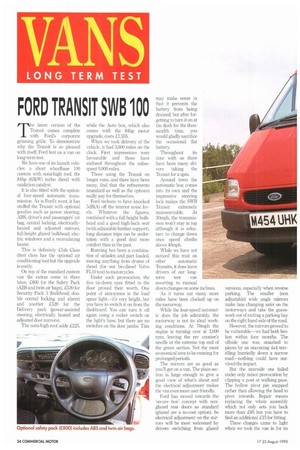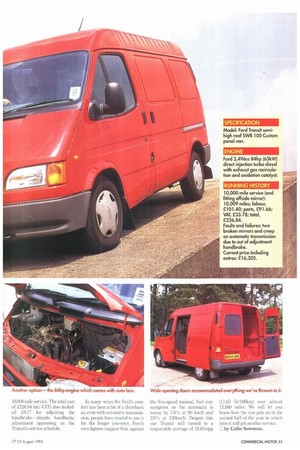FORD TRANSIT St , 11B 100 T he latest version of the Transit
Page 36

Page 37

If you've noticed an error in this article please click here to report it so we can fix it.
comes complete with Ford's corporate grinning grille. To demonstrate why the Transit is so pleased with itself, Ford lent us a van on long-term test.
We have one of its launch vehicles: a short wheelbase 100 custom with semi-high roof, the 84hp (63kW) turbo diesel with oxidation catalyst.
It is also fitted with the optional four-speed automatic transmission. As is Ford's wont, it has stuffed the Transit with optional goodies such as power steering, ABS, driver's and passengers' air bag, central locking, electricallyheated and adjusted mirrors, full-height glazed bulkhead, electric windows and a recirculating heater.
This is definitely Club Class (first class has the optional air conditioning too) but the upgrade is costly.
On top of the standard custom van the extras come in three bites; £800 for the Safety Pack (ABS and twin air bags), £520 for Security Pack 3 (bulkhead, double central locking and alarm) and another £520 for the Delivery pack (power-assisted steering, electrically heated and adjusted door mirrors).
The semi-high roof adds £225, while the Auto box, which also comes with the 84hp motor upgrade, costs 41,555.
When we took delivery of the vehicle, it had 3,600 miles on the clock. First impressions were favourable and those have endured throughout the subsequent 9,000 miles.
Those using the Transit on longer runs, and there have been many, find that the refinements (standard as well as the options) really pay for themselves.
Ford reckons to have knocked 5dB(A) off the interior noise levels. Whatever the figures, combined with a full height bulkhead and a good high-back seat (with adjustable lumbar support), long distance trips can be undertaken with a good deal more comfort than in the past.
Running has been a combination of unladen and part loaded, moving anything from drums of diesel (for our bio-diesel Volvo FL10 test) to motorcycles.
Under such provocation, the five tie-down eyes fitted in the floor proved their worth. One point of annoyance is the load space light—it's very bright, but you have to switch it on from the dashboard. You can turn it off again using a rocker switch on the light's base, but there are no switches on the door jambs. This may make sense in that it prevents the battery from being drained, but after forgetting to turn it on at the dash for the thousandth time, you would gladly sacrifice the occasional fiat battery Throughout its time with us there have been many drivers taking the Transit for a spin.
Around town the automatic box comes into its own and the impressive steering lock makes the SWB Transit extremely manoeuvrable. At 30mph, the transmission won't stay in top although it is reluctant to change down once speed climbs above 40mph.
While we have not noticed this trait on other automatic Transits, it dos leave drivers of our longterm test van resorting to manual down changes on some As it turns out many more miles have been clocked up on the motorway.
While the four-speed automatic does the job admirably, the motorway is not its ideal working conditions. At 70mph the engine is turning over at 3,000 i.pm, leaving the rev counter's needle at the extreme top end of the green section. Not the most economical area to be running for prolonged periods.
The mirrors are as good as you'll get on a van. The plain section is large enough to give a good view of what's about and the electrical adjustment makes the van even more user friendly.
Ford has moved towards the 'secure box' concept with nonglazed rear doors as standard (glazed are a no-cost option). So electrical adjustment on the mirrors will be most welcomed by drivers switching from glazed versions, especially when reverse parking. The smaller (non adjustable) wide angle mirrors make lane changing safer on the motorways and take the guesswork out of exiting a parking bay on the right hand side of the road.
However, the mirrors proved to be vulnerable—we had both broken within four months. The offside one was smashed to pieces by an oncoming 4x4 travelling hurriedly down a narrow road—nothing could have survived the impact.
But the nearside one failed under only minor provocation by clipping a post at walking pace. The hollow pivot pin snapped rather than allowing the head to pivot inwards. Repair means replacing the whole assembly which not only sets you back more than £65 but you have to find an additional £15 for fitting.
These charges came to light when we took the van in for its
WOO mile service. The total Cost of £226.84 (inc-VAT) also included £9.17 for adjusting the handbrake—despite handbrake adjustment appearing on the Transit's service schedule.
In many ways the Ford's comfort has been a bit of a drawback as, even with automatic transmission, people have tended to use it for the longer journeys. Ford's own figures suggest that, against the five-speed manual, fuel consumption on the automatic is worse by 7.6% at 90 km/h and 2.6% at 120km1h. Despite this our Transit still turned in a respectable average of 24.81mpg
(11.65 lit1100km) over almost 11,000 miles. We will let you know how the van gets on in the second half of the year in which time it will get another service.
0 by Colin Sowman.
























































































